Office interior design is an exciting and essential element of any workspace. A well-designed office space can boost employee productivity, increase client retention, and even attract new business. Your office interior design should reflect your brand identity, enhance collaboration and workflow, and provide a comfortable and functional workspace for employees.
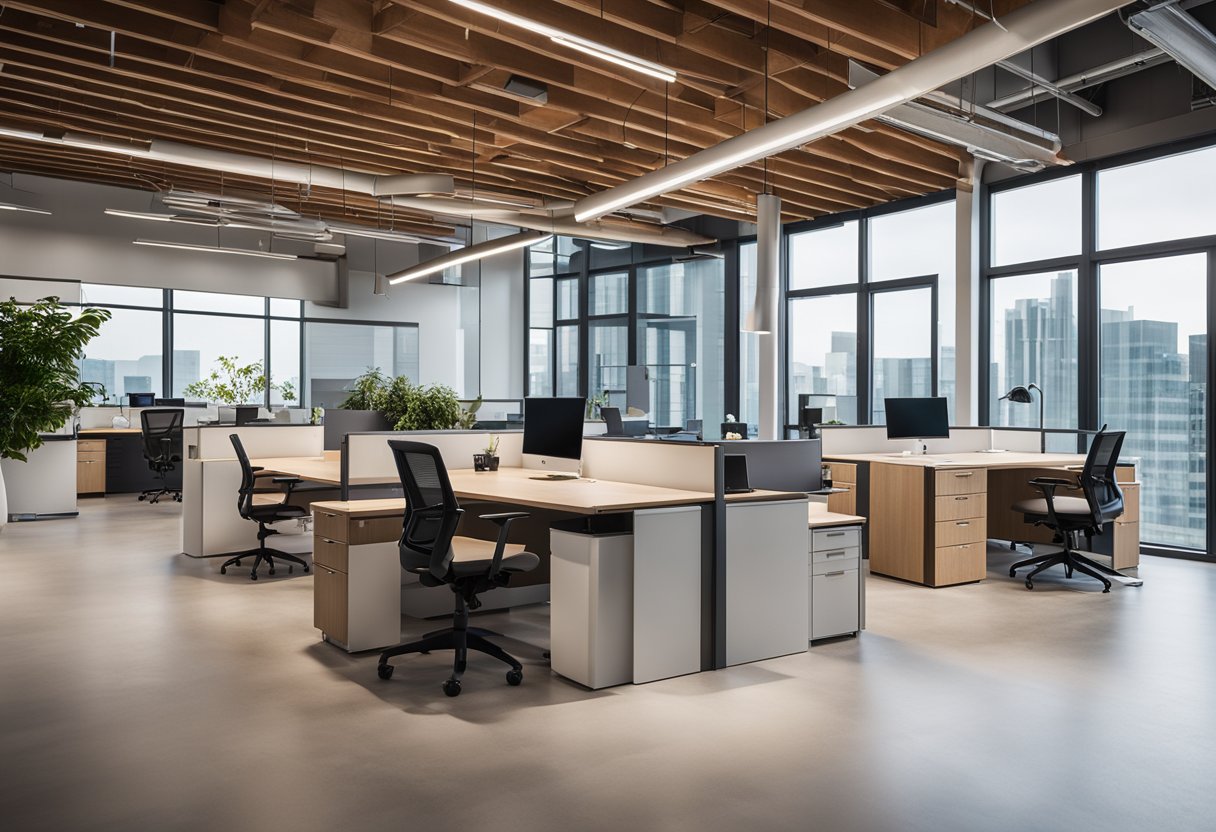
To understand office interior design, you need to consider the various elements that make up a workspace. These include the layout, furniture, lighting, colour, and materials used. Each of these elements plays a critical role in creating an environment that is conducive to work. A well-designed office space can help to reduce stress, boost creativity, and improve employee well-being.
Planning your office space is a crucial step in the office renovation process. You need to consider your business needs, the size of your workforce, and your budget. It’s essential to work with an experienced interior design company that can help you to create a workspace that meets your specific requirements. Collaboration and workflow optimisation are also critical factors to consider when designing your office space.
Key Takeaways
- A well-designed office space can boost employee productivity and improve client relations.
- Planning your office space is a crucial step in the office renovation process.
- Collaboration and workflow optimisation are critical factors to consider when designing your office space.
Understanding Office Interior Design
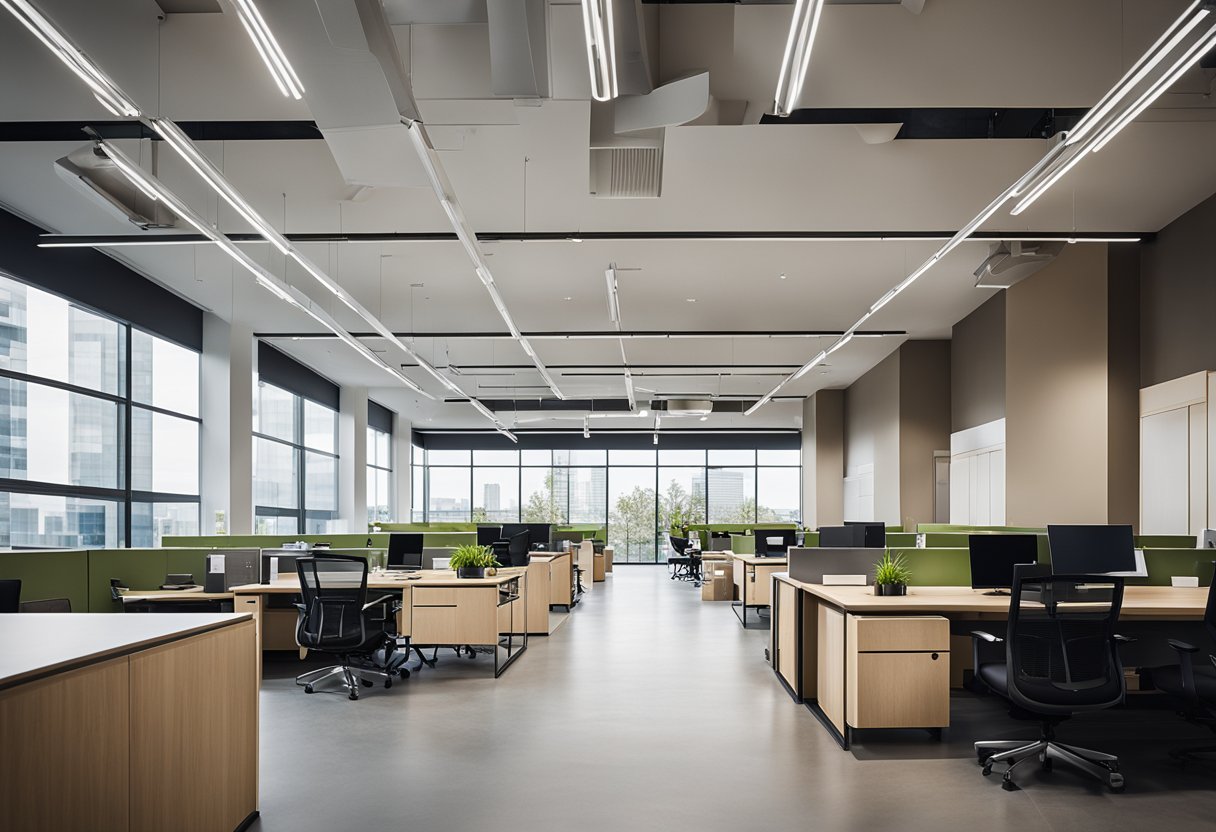
When it comes to office interior design, it’s essential to create a space that is both functional and aesthetically pleasing. The design of your office can have a significant impact on your employees’ productivity, creativity, and overall well-being.
The Role of Aesthetics in Productivity
The aesthetic appeal of your office can have a significant impact on your employees’ productivity. A well-designed office can create a positive and inspiring atmosphere, which can help your employees stay focused and motivated throughout the day.
One way to enhance the aesthetics of your office is by incorporating natural elements such as plants and natural lighting. Studies have shown that exposure to natural light can improve mood, energy levels, and overall well-being, which can lead to increased productivity and creativity.
Innovative Design Office Trends
Innovative office design trends are constantly emerging, and it’s essential to stay up-to-date with the latest trends to create a modern and inspiring workspace. One of the most popular trends in office design is the use of open spaces, which can promote collaboration and communication among employees.
Another popular trend is the use of ergonomic furniture, which can help reduce the risk of injury and improve employee comfort and well-being. Additionally, the use of technology such as smart lighting and temperature control systems can enhance the functionality of your office and improve employee productivity.
In conclusion, office interior design plays a crucial role in creating a productive and inspiring workspace. By incorporating innovative design trends and prioritizing aesthetics, you can create a space that promotes creativity, collaboration, and employee well-being.
Planning Your Office Space
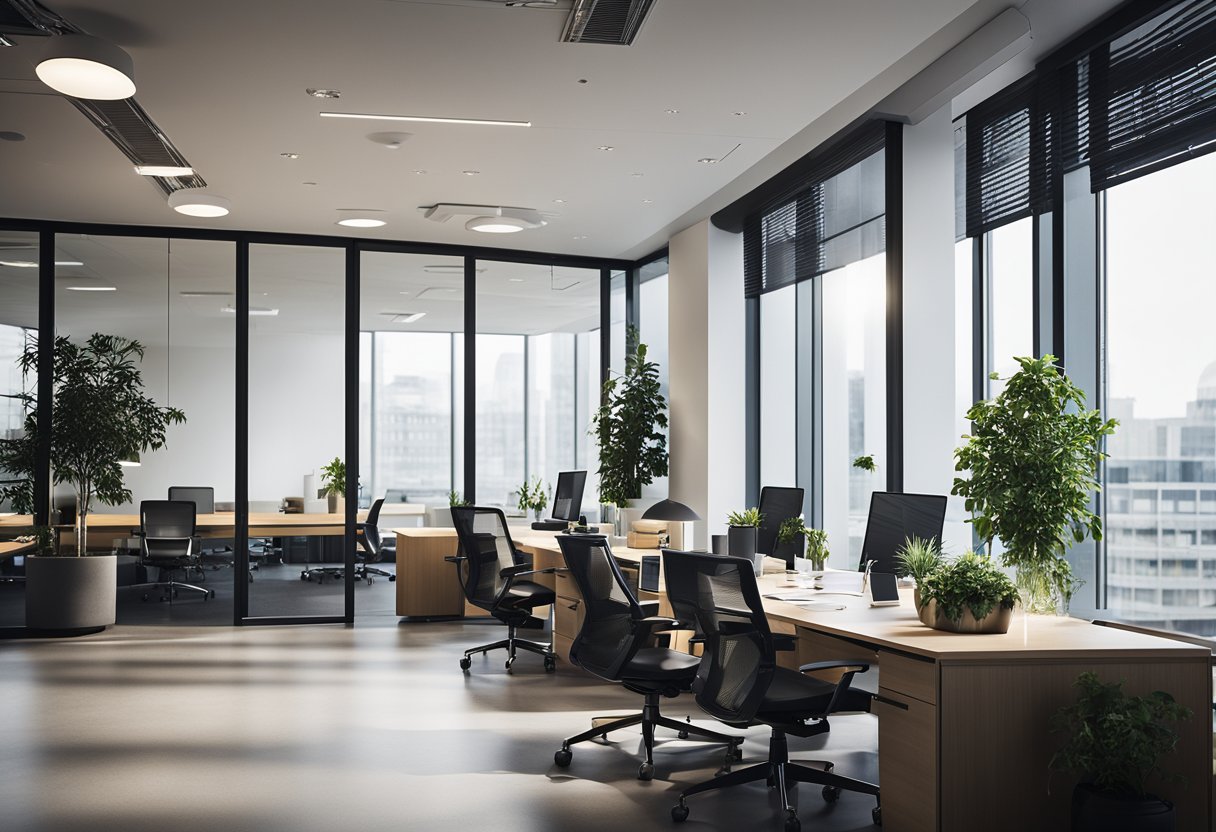
When it comes to office interior design, one of the most important aspects is space planning. This involves analyzing the space requirements of your workspace and developing effective strategies to make the most of the available space.
Space Requirement Analysis
Before planning your office space, it’s important to understand the space requirements of your business. This involves considering factors such as the number of employees, the nature of their work, the type of equipment required, and the amount of storage space needed.
To determine your space requirements, you should conduct a thorough analysis of your business operations. This may involve conducting surveys or interviews with employees, reviewing workflow processes, and assessing the amount of space required for each task.
Effective Space Planning Strategies
Once you have a clear understanding of your space requirements, it’s time to develop effective space planning strategies. Here are some tips to help you make the most of your workspace:
- Consider open-plan layouts: Open-plan layouts can help to maximize space and encourage collaboration. This involves creating a large, open space that is divided into different work areas using partitions or screens.
- Use multifunctional furniture: Multifunctional furniture, such as desks with built-in storage or chairs that can be used for seating and storage, can help to save space and increase efficiency.
- Utilize vertical space: Don’t forget to make use of vertical space by installing shelves or storage units that reach up to the ceiling.
- Create flexible work areas: Creating flexible work areas that can be easily reconfigured to accommodate different tasks can help to make the most of your space.
By following these space planning strategies, you can create a workspace that is both functional and efficient, helping to boost productivity and improve the overall working environment.
The Office Renovation Process
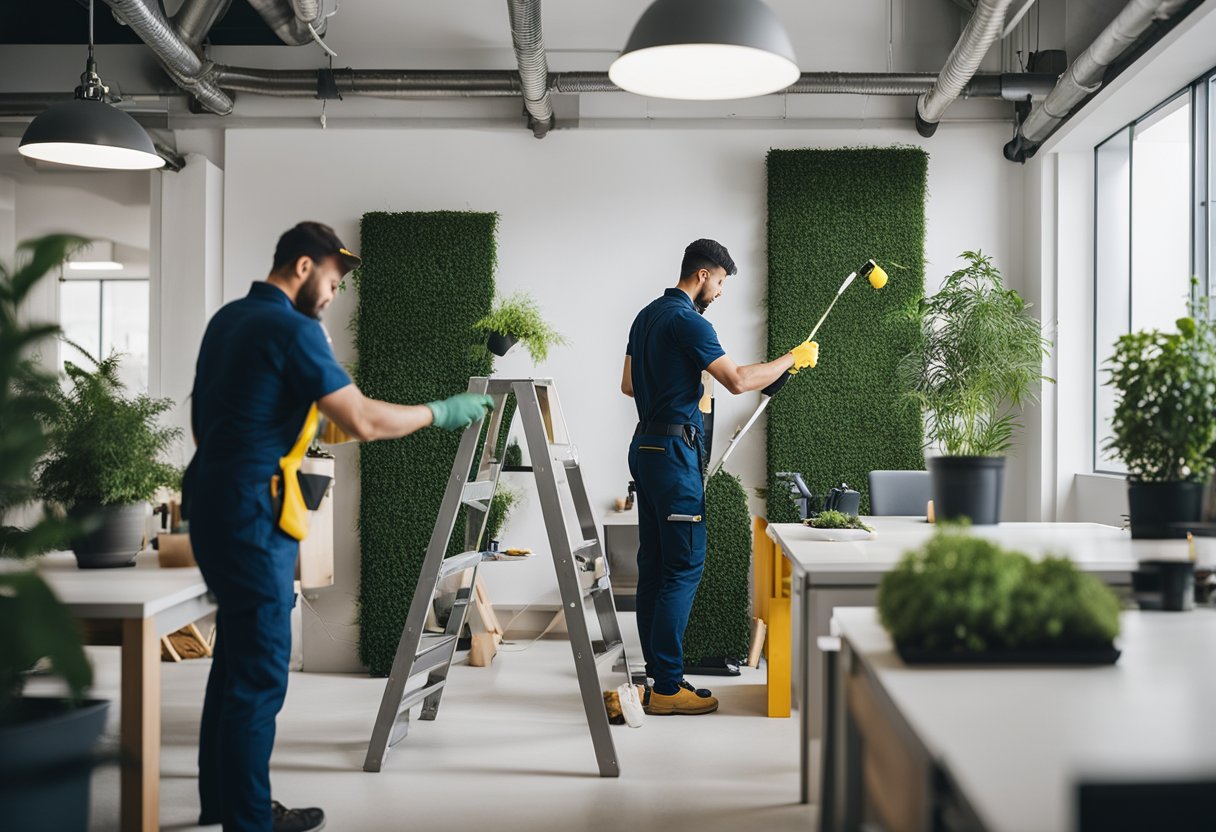
If you’re planning to renovate your office, you need to know what to expect from the process. Office renovation can be a complex and time-consuming task, but with proper planning and execution, it can be a rewarding experience. Here are some key stages of the office renovation process:
Key Stages of Renovation
- Planning: This is the most critical stage of the renovation process. It involves identifying your goals, budget, and timeline. You should also consider factors such as the size of your office, the number of employees, and the type of work you do. Planning will help you to avoid costly mistakes and ensure that your renovation meets your needs.
- Design: Once you have a clear idea of what you want to achieve, it’s time to start designing your new office. You can work with an interior designer or architect to create a layout that maximizes your space and enhances your productivity. Be sure to consider factors such as lighting, acoustics, and ergonomics.
- Construction: This is where the actual work begins. You’ll need to hire a contractor and a team of tradespeople to carry out the renovation. It’s important to stay in touch with your contractor to ensure that the work is progressing according to plan. You should also be prepared for unexpected delays or issues that may arise during the construction process.
- Finishing: Once the construction is complete, it’s time to add the finishing touches. This includes painting, flooring, and installing fixtures such as lighting and furniture. You should also take the time to clean up the space and ensure that everything is in working order.
Staying on Time and Within Budget
Staying on time and within budget is essential to the success of your office renovation. To ensure that you stay on track, you should:
- Set a realistic budget: Be sure to factor in all costs, including labour, materials, and permits.
- Create a timeline: Work with your contractor to create a timeline that outlines the key milestones of the renovation.
- Communicate regularly: Stay in touch with your contractor to ensure that the work is progressing according to plan.
- Be flexible: Be prepared to make adjustments to your plans if unexpected issues arise.
- Keep records: Keep detailed records of all expenses and invoices to help you stay on top of your budget.
By following these tips, you can ensure that your office renovation is a success. With careful planning and execution, you can create a workspace that is both functional and inspiring.
Selecting the Right Interior Design Company
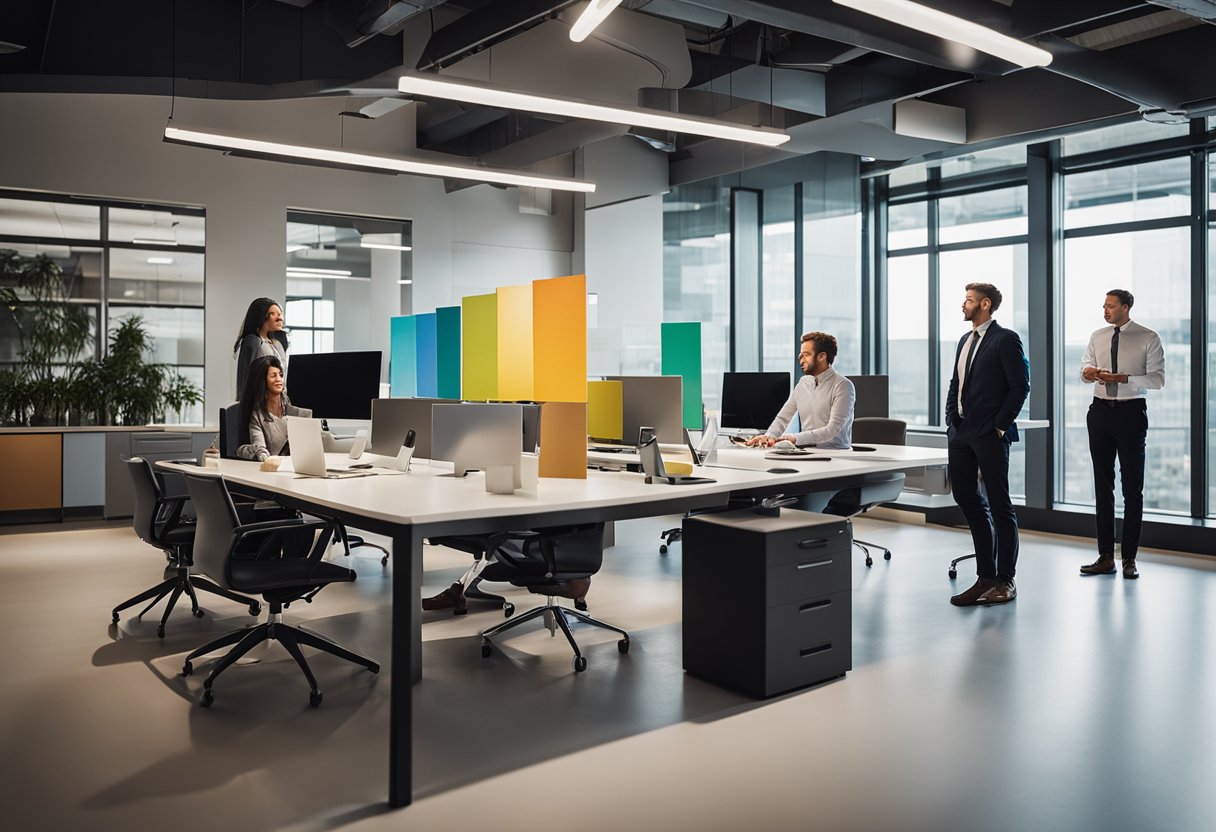
When it comes to office interior design, selecting the right interior design company can make all the difference. The right company can help you create a workspace that is not only functional but also aesthetically pleasing. Here are some things to consider when selecting an interior design company for your office:
Evaluating Expertise and Successful Projects
One of the most important things to consider when selecting an interior design company for your office is their expertise and successful projects. You want to work with a company that has experience in designing offices and has a portfolio of successful projects to show for it. Look for companies that have experience in designing offices similar to yours, whether it’s in terms of size, industry or style.
You can also evaluate their expertise by looking at their certifications and qualifications. For example, some interior design companies may have certifications in green design, which can be important if you want to create an eco-friendly workspace.
Clientele and Customer Satisfaction
Another important factor to consider when selecting an interior design company is their clientele and customer satisfaction. Look for companies that have worked with reputable clients and have positive reviews from past customers. You can look for reviews on their website or on third-party review sites.
It’s also important to consider their communication and collaboration skills. You want to work with a company that is responsive to your needs and can effectively communicate with you throughout the design process.
Overall, selecting the right interior design company for your office can be a challenging but rewarding process. By evaluating their expertise and successful projects, as well as their clientele and customer satisfaction, you can find a company that can help you create the perfect workspace for your business.
Collaboration and Workflow Optimisation
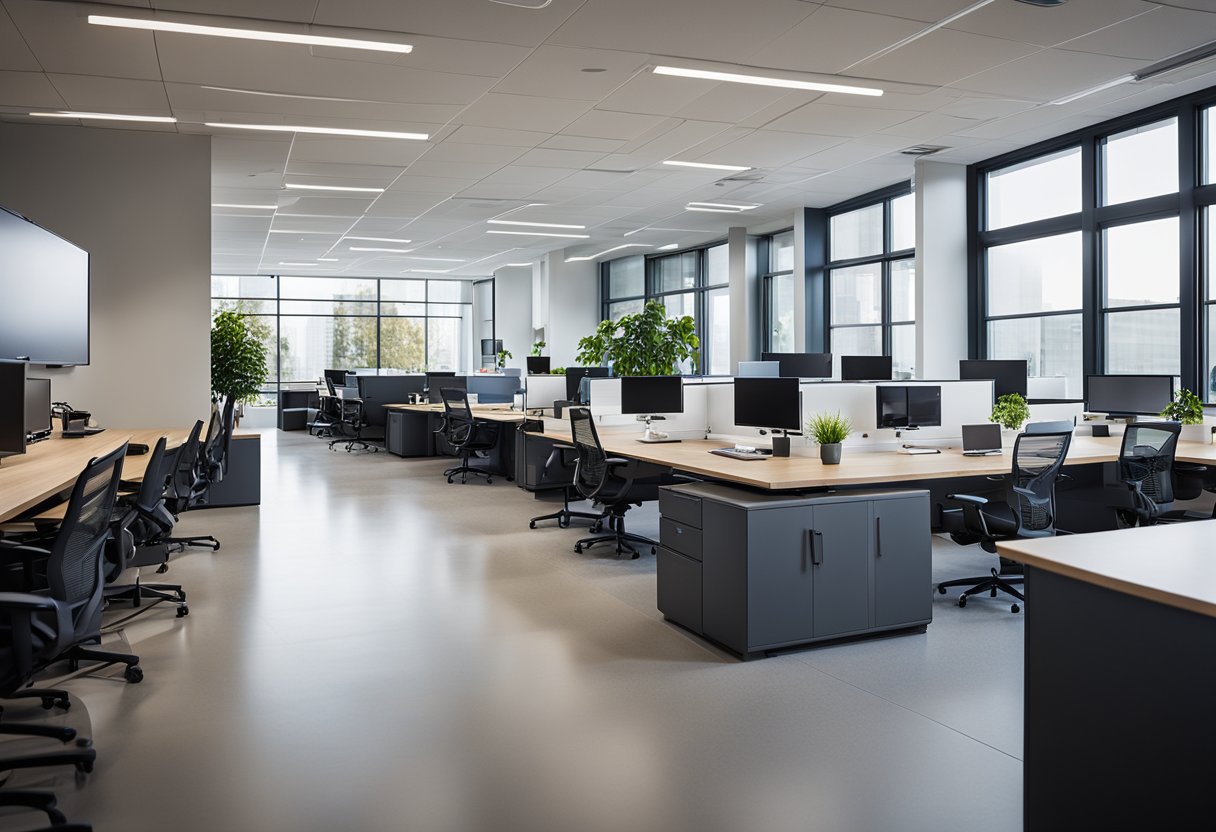
Collaboration and workflow are two essential components that can make or break a successful team. When designing your office, it’s important to keep these aspects in mind to foster a collaborative environment and streamline workflow processes. In this section, we’ll discuss two key areas to focus on when designing your office for collaboration and workflow optimization: Fostering Team Collaboration and Workflow Enhancement Through Design.
Fostering Team Collaboration
Collaboration is crucial in today’s work environment. When team members work together, they can share ideas, knowledge, and expertise to achieve better results. To foster team collaboration, consider the following design elements:
- Open-plan spaces: Open-plan spaces can encourage team members to interact and work together. This design approach can also help to break down silos and encourage cross-functional collaboration.
- Collaborative areas: Designate collaborative areas for team members to work together on projects. These areas can include whiteboards, projectors, and other tools to facilitate collaboration.
- Breakout spaces: Breakout spaces provide a change of scenery from the traditional workspace and can encourage team members to collaborate in a more relaxed environment.
Workflow Enhancement Through Design
Efficient workflow processes are crucial in any workplace. When designing your office, consider how the layout and design can enhance workflow processes. Here are a few design elements to consider:
- Task-based workstations: Task-based workstations can help team members stay focused on their specific tasks and minimize distractions.
- Ergonomic furniture: Ergonomic furniture can help team members stay comfortable and focused for longer periods, which can lead to increased productivity.
- Optimized layout: Optimize the office layout to minimize unnecessary movement and maximize efficiency. For example, placing printers and other shared resources in a central location can save time and reduce distractions.
By focusing on collaboration and workflow optimization when designing your office, you can create an environment that promotes teamwork, productivity, and success.
Integrating Brand Identity
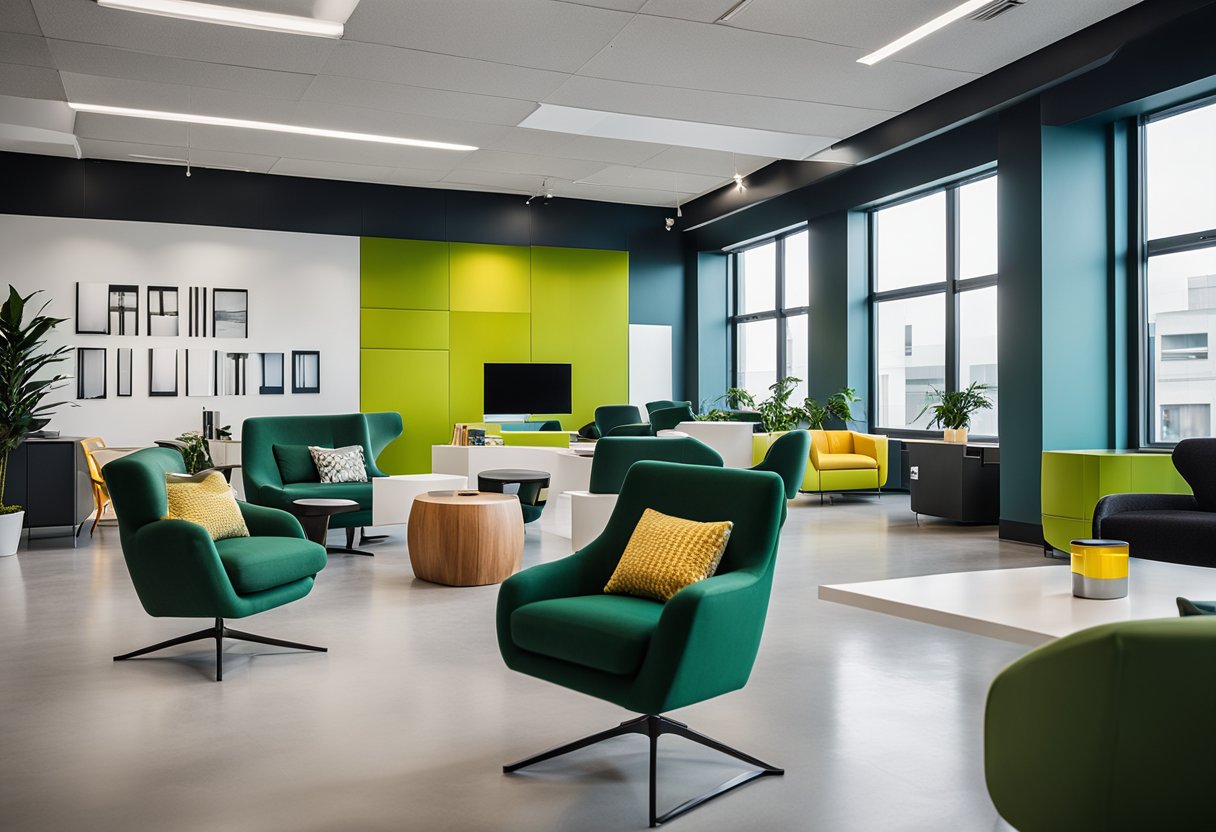
When it comes to office interior design, one of the key considerations is how to effectively integrate your brand identity into the space. By doing so, you can create a cohesive and engaging environment that reflects your company’s personality and values.
Branding Through Design
One way to integrate your brand identity into your office interior design is by using design elements that are consistent with your brand’s visual identity. This can include using your brand’s colours, typography, and imagery throughout the space. For example, if your brand is known for its use of bold, bright colours, you might incorporate these colours into the furniture, walls, and decor of your office.
Another way to reinforce your brand identity through design is by using materials and textures that are consistent with your brand’s values. For example, if your brand is known for its commitment to sustainability, you might choose eco-friendly materials for your office furniture and decor.
Aligning Interiors with Brand Values
In addition to using design elements that are consistent with your brand’s visual identity, it’s also important to consider how your office interior design can align with your brand’s values. This can include creating spaces that are conducive to collaboration and creativity if your brand values innovation, or incorporating elements of nature if your brand values sustainability.
By aligning your office interiors with your brand values, you can create a space that not only reflects your brand’s personality but also reinforces its core values. This can help to create a more engaged and motivated workforce, as well as a more positive impression on clients and visitors to your office.
Overall, integrating your brand identity into your office interior design is an important consideration for any business looking to create a cohesive and engaging workspace. By using design elements that are consistent with your brand’s visual identity and aligning your interiors with your brand values, you can create a space that reflects your brand’s personality and reinforces its core values.
Functional Aspects of Office Design
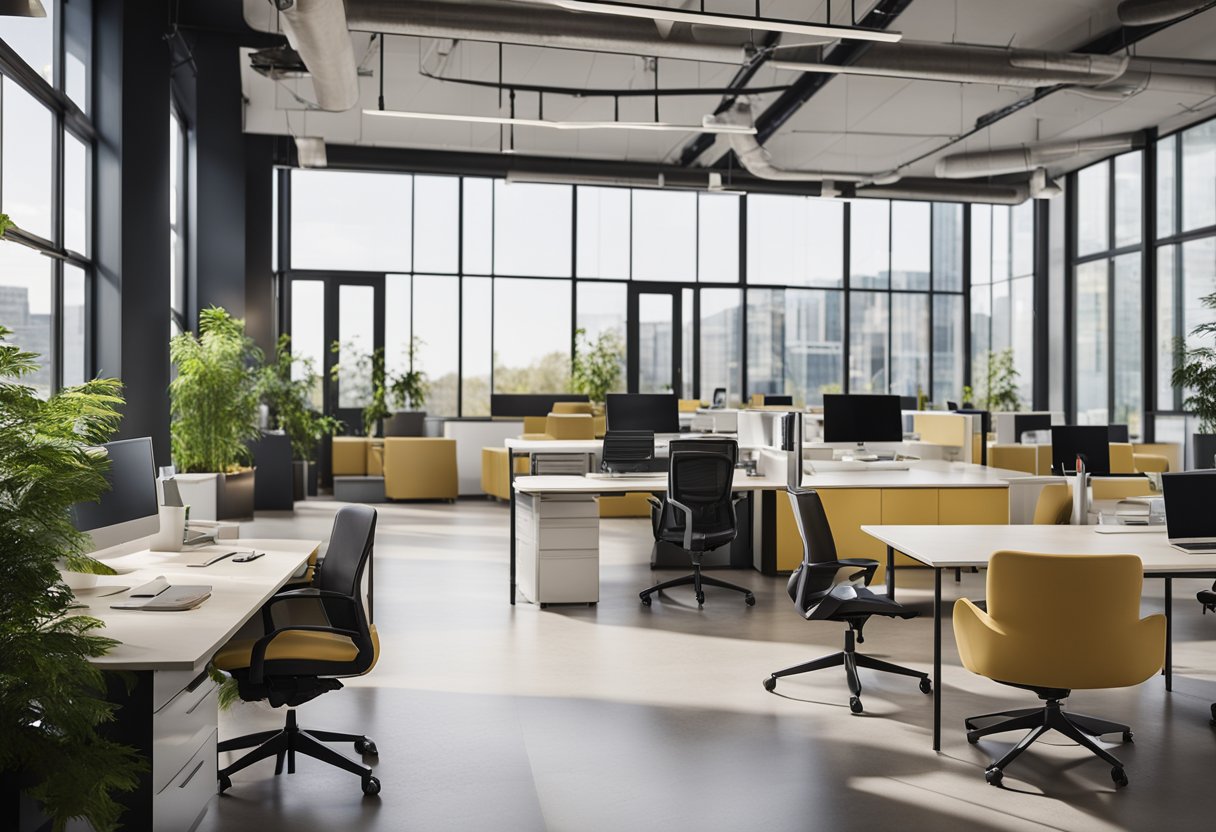
Designing a functional office space is essential for creating a productive and efficient work environment. Here are some key considerations to keep in mind when designing your office space.
Incorporating Efficient Flooring and Plumbing
When it comes to office design, flooring and plumbing are often overlooked. However, they play a crucial role in the functionality of your office space.
Efficient flooring can help reduce noise levels and create a comfortable work environment. Consider using carpets or rugs to absorb sound and create a more relaxed atmosphere. Alternatively, hardwood or vinyl flooring can be used for a more modern and professional look.
Plumbing is also an important consideration in office design. Make sure your plumbing is up-to-date and properly installed to avoid any issues with leaks or drainage. This will help ensure a clean and hygienic work environment.
Designing for the Work Environment
The work environment is another important consideration when designing your office space. Your office design should promote productivity, creativity, and well-being among your employees.
Consider incorporating natural light into your office space to create a bright and inviting atmosphere. This can be achieved through the use of large windows or skylights.
Ergonomic furniture is also important for creating a comfortable work environment. Make sure your chairs, desks, and other furniture are adjustable and provide proper support to prevent back pain and other workplace injuries.
In conclusion, when designing a functional office space, it’s important to consider all aspects of your design, including flooring, plumbing, and the work environment. By incorporating these key considerations into your design, you can create a productive and efficient work environment that promotes employee well-being and creativity.
Project Management and Execution
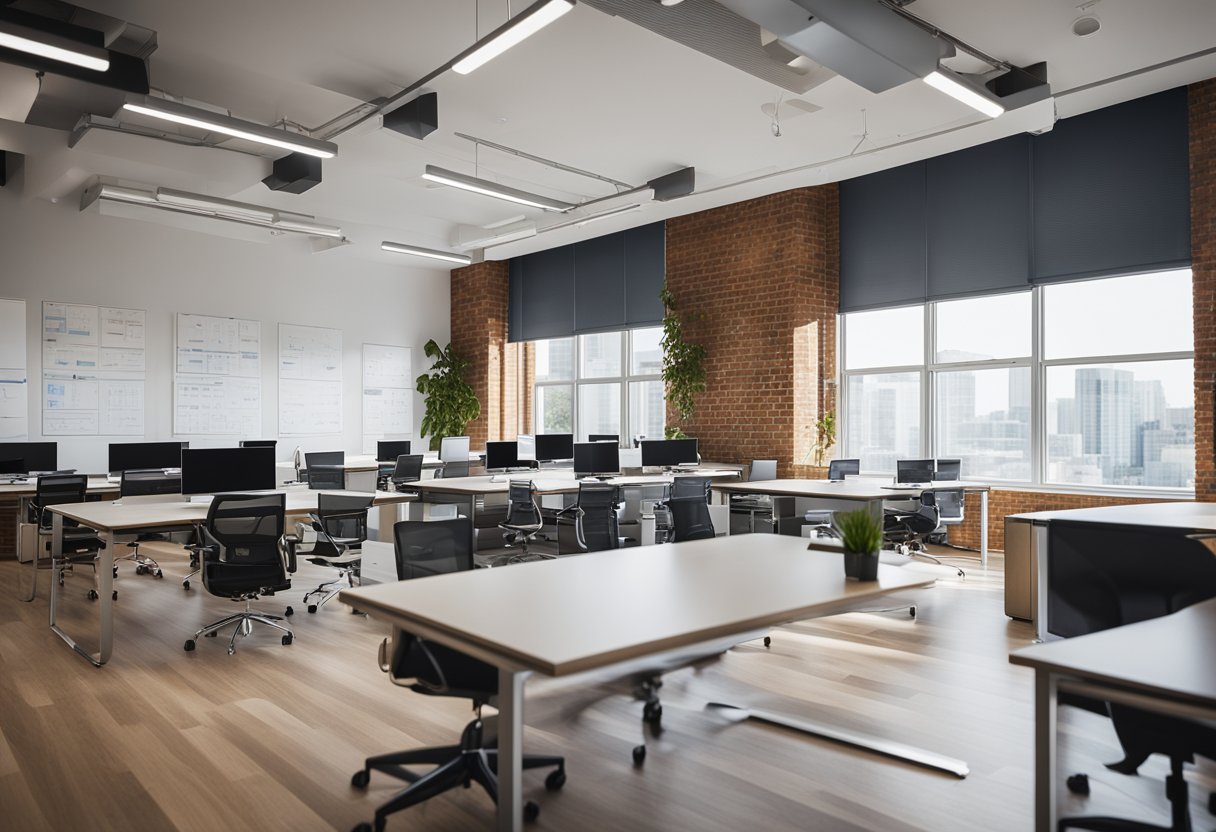
As you embark on your office interior design project, it’s crucial to have a well-planned project management strategy to ensure its success. Project management involves coordinating all aspects of the project, from scheduling to budgeting, to ensure that it’s completed on time and within budget. Here are some key elements to consider when managing your office interior design project.
Ensuring Project Delivery
One of the most critical aspects of project management is ensuring that the project is delivered on time. To achieve this, you need to have a clear understanding of the project’s scope, timeline and budget. You should also have a robust communication plan in place to keep everyone involved in the project informed and up-to-date on progress.
To help you stay on track, you can use project management software to manage your project’s timeline, tasks and milestones. This software can help you identify potential delays and bottlenecks, so you can take action to keep the project moving forward.
Construction Coordination
Another essential aspect of project management is coordinating the construction process. This involves overseeing the work of contractors, ensuring that they’re following the project plan and schedule, and managing any issues that arise.
To ensure that the construction process runs smoothly, you need to have a clear understanding of the construction process and the roles of each contractor involved. You should also have a detailed construction schedule that outlines each step of the process, from demolition to final installation.
By effectively managing your office interior design project, you can ensure that it’s completed on time, within budget, and to your satisfaction. With the right project management strategy in place, you can avoid delays, minimise risks and achieve your goals.
The Impact of Design on Client Relations
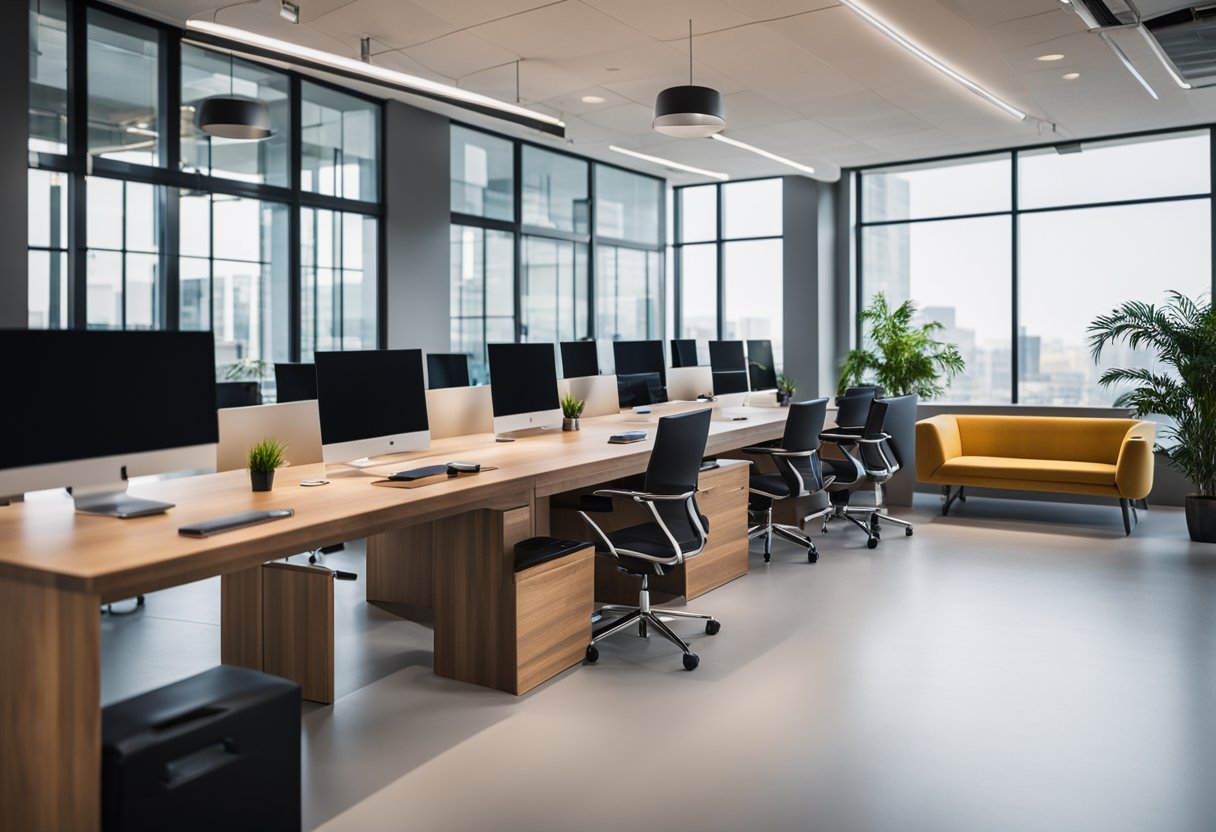
When it comes to office interior design, it’s not just about creating a visually appealing workspace. Design can have a significant impact on client relations, influencing the way they perceive your business and their overall experience with your company. In this section, we’ll explore how design can influence client relations and what you can do to create a positive impact on your clients.
Design Influence on Clientele Experience
The design of your office space can have a significant impact on the experience your clients have when they visit your premises. A well-designed office space can create a welcoming and professional atmosphere, making clients feel comfortable and at ease. On the other hand, a poorly designed space can create a negative impression, leaving clients feeling uncomfortable and unimpressed.
To create a positive impact on your clients, it’s important to consider the layout, lighting, colours, and overall aesthetic of your office space. By incorporating personalised elements like 3D figurines, you can create a workspace that is not only visually appealing but also reflects your brand and values.
Office Spaces Reflecting Company Values
Your office space is a reflection of your company’s values and culture. By incorporating design elements that reflect your company’s values, you can create a workspace that not only looks great but also reinforces your brand identity.
For example, if your company values innovation and creativity, you may want to incorporate bright colours and unique design elements into your office space. If your company values professionalism and sophistication, you may want to opt for a more classic and timeless design.
By creating an office space that reflects your company’s values, you can create a positive impression on your clients and reinforce your brand identity. This can lead to increased customer satisfaction and loyalty, ultimately leading to long-term business success.
In summary, the impact of office interior design goes far beyond the surface, influencing client perceptions and shaping a conducive environment for both employees and visitors. By prioritising aesthetics, functionality, and the incorporation of personalised elements like 3D figurines, businesses can create a workspace that is not only visually appealing but also reflects their brand and values.
Sustainable Office Interior Solutions
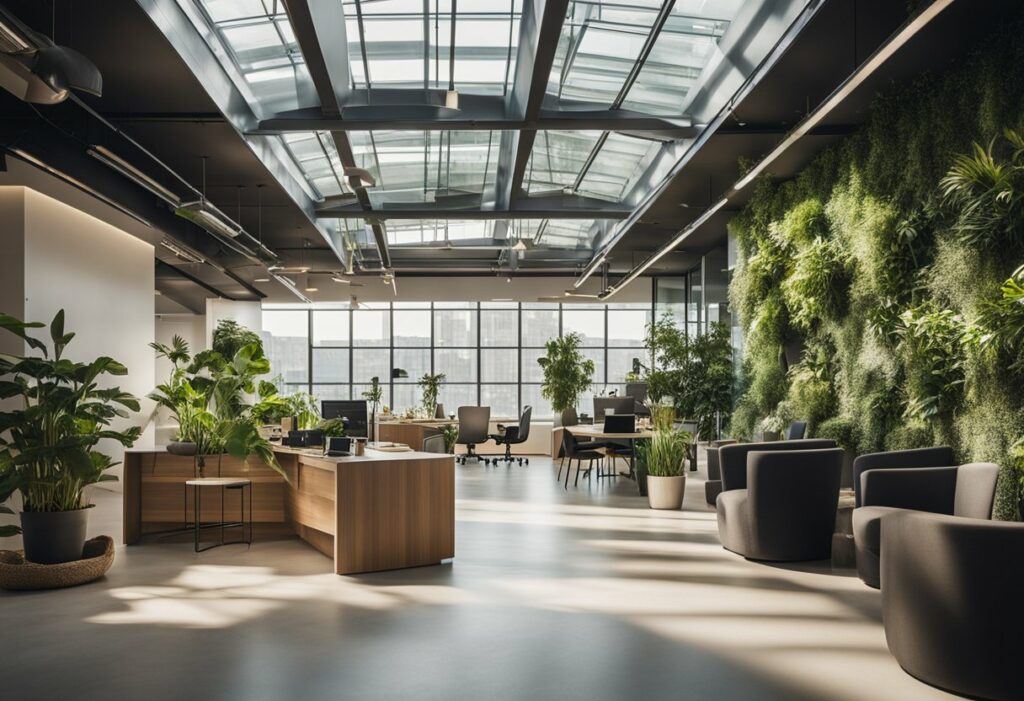
Creating a sustainable office interior is a crucial aspect of modern office design. By adopting eco-friendly materials and practices, you can reduce your carbon footprint and create a healthier workspace. Here are some sustainable office interior solutions that you can implement:
Eco-friendly Materials and Practices
One of the most significant ways to create a sustainable office interior is by using eco-friendly materials and practices. This includes using recycled materials, reducing waste, and adopting energy-efficient solutions. For instance, you can use LED lighting, which consumes less energy and lasts longer than traditional lighting. You can also use sustainable materials such as bamboo, recycled wood, and low VOC paints.
In Singapore, there are several companies that specialize in sustainable office interior design. They can help you choose the right materials and practices that align with your sustainability goals. By working with a reputable company, you can ensure that your office interior is not only sustainable but also aesthetically pleasing.
Long-term Sustainability in Design
Another crucial aspect of sustainable office interior design is long-term sustainability. This means designing an office that is not only sustainable now but also in the future. For instance, you can design an office that is flexible and adaptable, allowing you to make changes as your business grows. You can also incorporate green spaces and natural light, which can improve air quality and boost productivity.
When designing a sustainable office interior, it is essential to consider the long-term impact on the environment. By adopting sustainable materials and practices and designing for long-term sustainability, you can create a healthier and more productive workspace while reducing your ecological footprint.
In conclusion, sustainable office interior design is the way of the future. By adopting eco-friendly materials and practices and designing for long-term sustainability, you can create a workspace that is not only aesthetically pleasing but also environmentally responsible. So, if you’re looking to create a sustainable office interior, consider working with a reputable company in Singapore that specializes in sustainable office interior design.
Technology in Office Interior Design
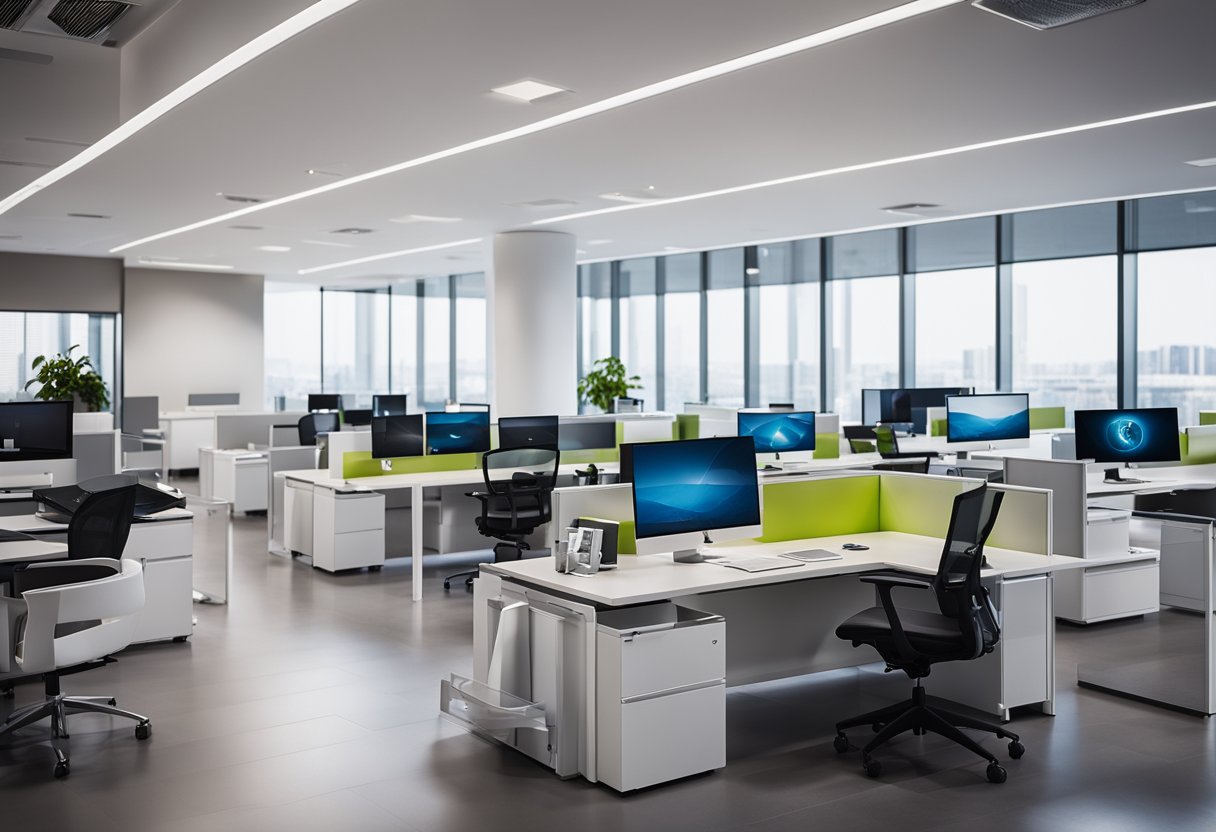
As technology continues to evolve, it is transforming every aspect of modern business, including office interior design. Innovative office designs are being created with tech-driven solutions that enhance productivity and improve the overall work experience.
Smart Office Innovations
Smart office innovations are revolutionising the way we work. With the help of IoT devices and sensors, offices can be designed to adapt to the needs of employees. For example, lighting and temperature can be automatically adjusted based on the time of day and the number of people in the room. This not only improves the comfort of the employees but also helps to reduce energy consumption.
Another example of smart office innovation is the use of virtual assistants. Voice-activated assistants such as Amazon’s Alexa can be integrated into the office environment, allowing employees to control various aspects of the office with their voice. This includes controlling the lighting, temperature, and even scheduling meetings.
Tech-Driven Productivity Solutions
The use of technology in office interior design is not just limited to creating a comfortable and convenient work environment. It can also be used to improve productivity. For example, the use of standing desks has become increasingly popular in recent years. Standing desks not only promote a healthier lifestyle but also help to boost productivity.
Another example of tech-driven productivity solutions is the use of collaboration tools. Collaboration tools such as Microsoft Teams and Slack allow employees to work together seamlessly, regardless of their location. This not only improves productivity but also helps to create a more connected and collaborative work environment.
In conclusion, technology is transforming the way we design office interiors. Smart office innovations and tech-driven productivity solutions are just a few examples of how technology is being used to create more innovative and productive workspaces. By embracing these solutions, you can create a more comfortable, convenient, and productive work environment for yourself and your employees.
The Future of Office Interiors
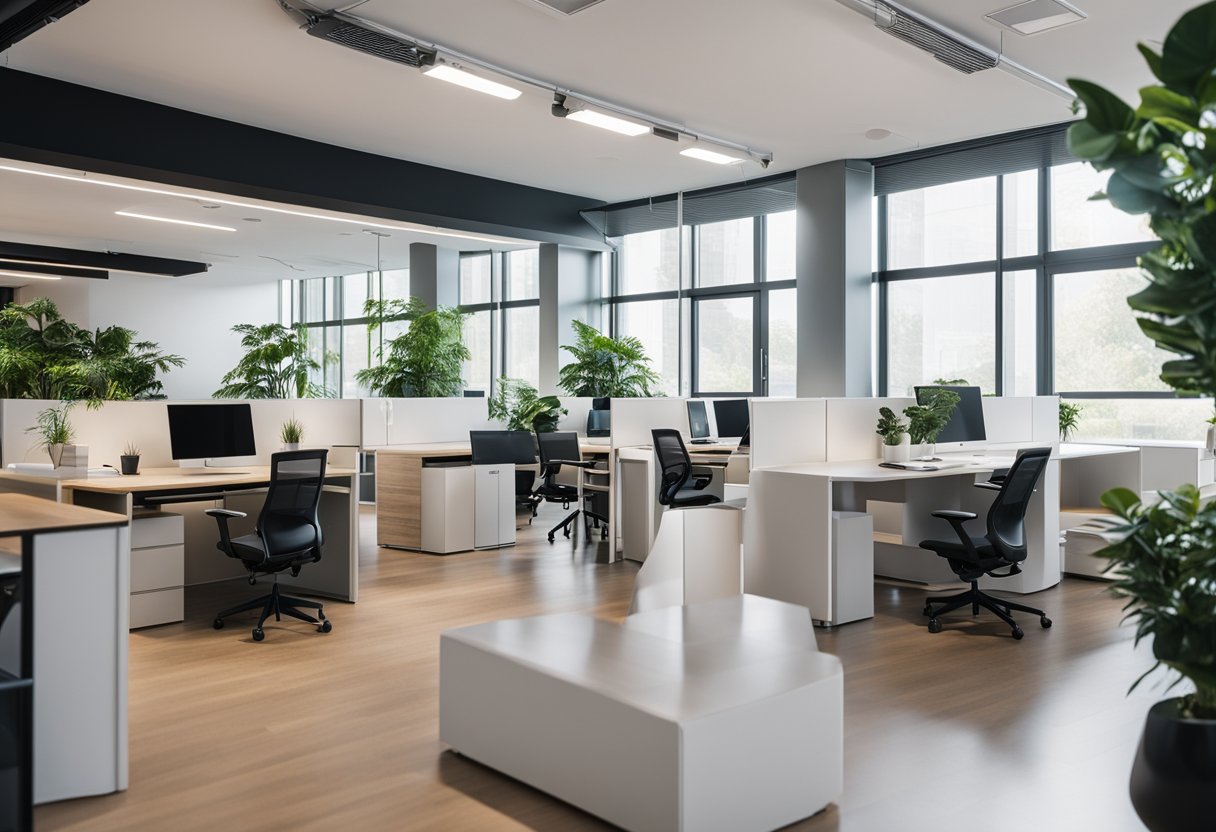
As the world of work continues to evolve, so too must the design of corporate interiors. The future of office interiors is an exciting prospect, with innovative ideas and designs emerging to create more functional, comfortable, and employee-centric workspaces. In this section, we’ll explore the latest trends in commercial office interior design and how they can help you adapt to the evolving needs of your workforce.
Predicting Trends in Corporate Interior Design
One of the most significant trends in corporate interior design is the move towards more flexible and adaptable workspaces. With remote work becoming more prevalent, many companies are looking for ways to create workspaces that support collaboration, creativity, and productivity, regardless of where their employees are located. This trend has led to the emergence of hybrid workspaces that combine traditional office layouts with flexible workstations, hot desks, and collaborative areas.
Another trend that is set to shape the future of office interiors is the use of technology to create smarter, more efficient workspaces. From smart lighting and temperature controls to integrated audio-visual systems, technology is being used to create workspaces that are more comfortable, productive, and energy-efficient.
Adapting to Evolving Workforce Needs
The future of office interiors is also about adapting to the evolving needs of the workforce. As the workforce becomes more diverse, companies need to create workspaces that cater to the needs of different generations, cultures, and working styles. This means creating workspaces that are more inclusive, accessible, and comfortable for everyone.
Another key consideration for the future of office interiors is sustainability. With climate change and environmental concerns at the forefront of many people’s minds, companies are looking for ways to create workspaces that are more sustainable and environmentally friendly. This means using sustainable materials, reducing energy consumption, and creating workspaces that encourage sustainable behaviours.
In summary, the future of office interiors is an exciting prospect, with many innovative ideas and designs emerging to create more functional, comfortable, and employee-centric workspaces. By predicting trends in corporate interior design and adapting to the evolving needs of the workforce, you can create workspaces that are both efficient and enjoyable to work in.
Conclusion
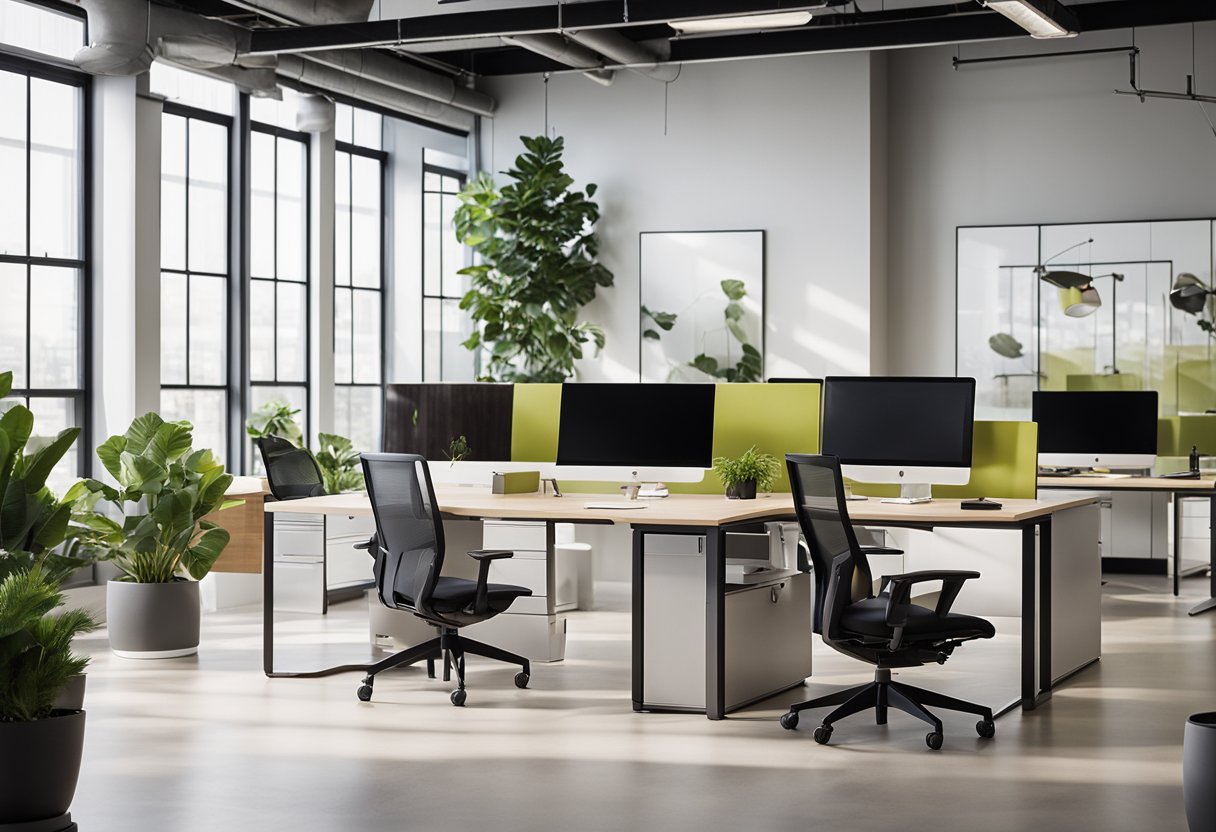
Congratulations! You have now learned about the importance of office interior design. By incorporating the right elements, you can create a workspace that is not only visually appealing but also promotes productivity and employee well-being.
In Singapore, where customer satisfaction is a top priority, it is crucial to have an office interior design that reflects your brand and values. By creating a space that is both functional and aesthetically pleasing, you can leave a lasting impression on your clients and employees.
Remember, when it comes to office interior design, every detail matters. From the lighting to the furniture, each element should be carefully considered to ensure that it contributes to the overall design and functionality of the space.
So, whether you are designing a new office or revamping an existing one, take the time to plan and execute your vision. With the right design elements, you can create a workspace that inspires creativity, boosts productivity, and promotes overall well-being.
Frequently Asked Questions

What are the latest trends in modern office interiors?
As we move towards a more modern and innovative work culture, office designs are also evolving. Some of the latest trends in modern office interiors include open-plan layouts, flexible workspaces, natural lighting, and biophilic design. These design trends create a more collaborative and relaxed work environment which fosters creativity and productivity.
How can we maximise space in a small office design?
Maximising space in a small office design requires careful planning and organisation. One of the best ways to maximise space is by using multifunctional furniture such as desks with built-in storage or modular shelving units. Additionally, incorporating natural lighting and neutral colours can create an illusion of more space.
What elements are crucial for a productive corporate office environment?
A productive corporate office environment requires a combination of elements such as ergonomic furniture, good lighting, and a comfortable temperature. In addition, incorporating greenery and natural elements such as plants can help reduce stress and increase productivity.
How do you select the perfect colour scheme for an office space?
Choosing the perfect colour scheme for an office space depends on the type of work that is being done and the desired atmosphere. For example, blue and green tones can create a calm and relaxing environment, while yellow and orange tones can promote creativity and energy. It is important to consider the company’s branding and the type of work being done when selecting a colour scheme.
What are the benefits of hiring a professional office design company?
Hiring a professional office design company can save time and money while ensuring that the office space is designed to meet the company’s specific needs. A professional designer can provide valuable insights and expertise on the latest design trends, space planning, and furniture selection. Additionally, a well-designed office can improve employee morale and productivity.
How does commercial interior design influence employee wellbeing?
Commercial interior design can have a significant impact on employee wellbeing. A well-designed office can reduce stress and promote mental and physical health. Incorporating natural elements such as plants and natural lighting can improve air quality and reduce symptoms of anxiety and depression. Additionally, ergonomic furniture and good lighting can reduce eye strain and physical discomfort.


